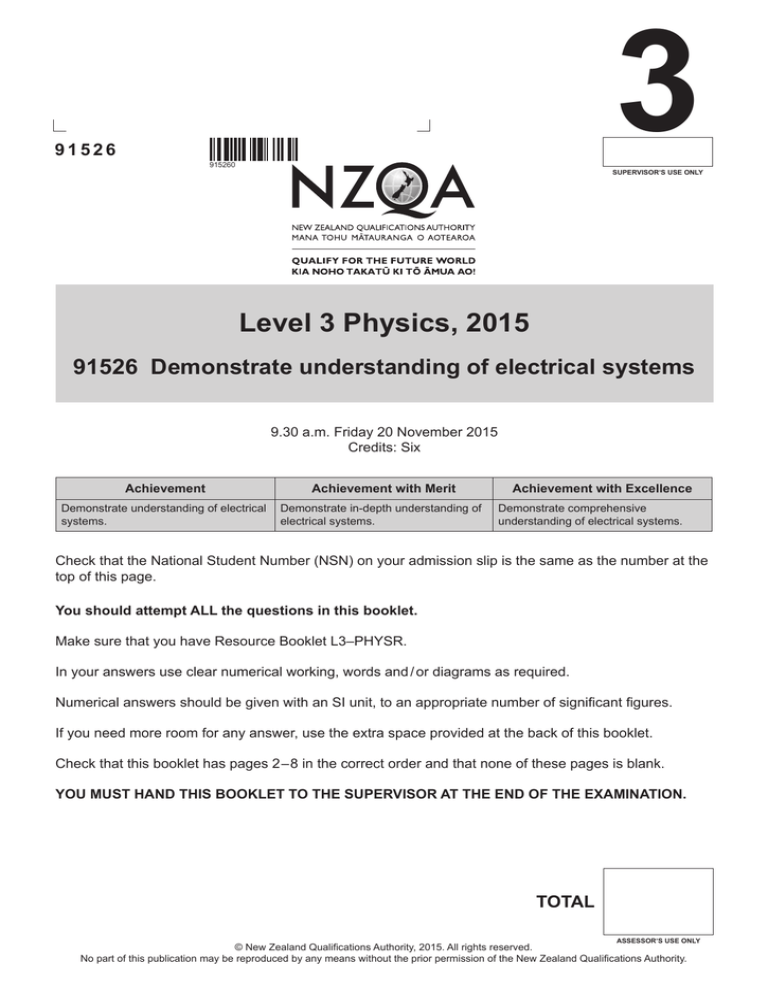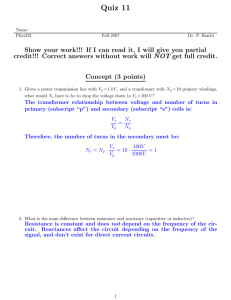
91526
3
915260
SUPERVISOR’S USE ONLY
Level 3 Physics, 2015
91526 Demonstrate understanding of electrical systems
9.30 a.m. Friday 20 November 2015
Credits: Six
Achievement
Achievement with Merit
Demonstrate understanding of electrical
systems.
Demonstrate in-depth understanding of
electrical systems.
Achievement with Excellence
Demonstrate comprehensive
understanding of electrical systems.
Check that the National Student Number (NSN) on your admission slip is the same as the number at the
top of this page.
You should attempt ALL the questions in this booklet.
Make sure that you have Resource Booklet L3–PHYSR.
In your answers use clear numerical working, words and / or diagrams as required.
Numerical answers should be given with an SI unit, to an appropriate number of significant figures.
If you need more room for any answer, use the extra space provided at the back of this booklet.
Check that this booklet has pages 2 – 8 in the correct order and that none of these pages is blank.
YOU MUST HAND THIS BOOKLET TO THE SUPERVISOR AT THE END OF THE EXAMINATION.
TOTAL
ASSESSOR’S USE ONLY
© New Zealand Qualifications Authority, 2015. All rights reserved.
No part of this publication may be reproduced by any means without the prior permission of the New Zealand Qualifications Authority.
2
QUESTION ONE: AC CIRCUITS
ASSESSOR’S
USE ONLY
An AC circuit has a variable capacitor, an inductor, and a resistor in series, as shown below.
12.0 VRMS, 50.0 Hz
C
0.150 H
(a)
10.0 Ω
Calculate the angular frequency of the supply.
(b) Show that the reactance of the inductor is 47.1 Ω.
(c)
When the variable capacitor has a value of 1.00 × 10–6 F, the voltage across the capacitor is
measured as 20.9 VRMS and the current flowing in the circuit is measured as 0.656 ARMS.
Calculate the voltages across the inductor and the resistor, and draw labelled phasors showing
the voltages across the capacitor, the inductor, and the resistor.
Physics 91526, 2015
3
(d) The variable capacitor is adjusted so that the circuit is now at resonance.
Explain, using physical principles, why the current is now a maximum, and calculate the
value of the current in the circuit at resonance.
Physics 91526, 2015
ASSESSOR’S
USE ONLY
4
QUESTION TWO: CAPACITORS
ASSESSOR’S
USE ONLY
Dielectric constant of air = 1.00
Permittivity of free space = 8.85 × 10 –12 F m–1
A 9.00 V cell is being used to charge a capacitor, as shown below.
r
A I = 0.208 A
V = 9.00 V
C
V V = 6.40 V
(a)
At one point during the charging, the capacitor has a voltage of 6.40 V, and the current
flowing in the circuit is 0.208 A.
Show that the internal resistance, r, of the cell is 12.5 Ω.
(b) The capacitor has air between its plates, and a plate separation of 2.26 × 10–4 m.
If the capacitor has a capacitance of 2.75 × 10–9 F, what is the overlap area of the plates?
(c)
Recently in the news, a teenager claimed to have
developed a super capacitor as a way of rapidly
charging a cell phone within 5 minutes. The actual
circuit in a cell-phone charger is complicated, but the
use of a capacitor to supply the energy to the charging
unit can be modelled using a simple circuit.
In the circuit shown, a capacitor with capacitance
15.0 F has already been charged to 5.00 V, and is
now discharged through a resistor, R, which represents
the charging unit.
Physics 91526, 2015
A
R
C = 15.0 F
V
5
Use the graph to show that the resistor is 4.50 Ω, and calculate the maximum current in the
circuit.
Capacitor voltage (volts)
Capacitor Voltage
6.00
5.00
4.00
3.00
2.00
1.00
0.00
0
50
100
150
200
250
300
Time (seconds)
(d) One particular cell phone requires about 6 × 105 joules of energy to fully charge. A super
capacitor of 400 F could be used to charge a cell phone that requires 5 V with a resistance of
4.5 Ω.
Use calculations to decide whether this capacitor would fully charge the cell phone within 5
minutes.
In your answer you should:
•
calculate the time taken for the capacitor to become effectively discharged
•
discuss whether the capacitor will release its energy within 5 minutes
•
calculate the energy released by the capacitor when discharging through the resistor
•
compare the energy released by the capacitor with the energy that would be required to
fully charge a cell phone.
Physics 91526, 2015
ASSESSOR’S
USE ONLY
6
QUESTION THREE: ELECTROMAGNETIC INDUCTION
There are a number of techniques used to detect cars and bicycles waiting at traffic lights. The most
common technique is the inductive loop circuit.
(a)
State how an inductor stores energy.
(b) One type of inductor loop circuit is shown below. This circuit contains a 9.00 V battery, with
an inductor of 1.00 × 10 –2 H, and a total resistance of 12.5 Ω in the circuit.
9.00 V
12.5 Ω
1.00 × 10–2 H
Soon after closing the switch, the current is 0.260 A.
Find the voltage across the resistor and the voltage across the inductor, and therefore calculate
the rate of change of current.
(c)
A different inductive loop circuit is constructed, as shown below.
9.00 V
When the switch is closed, the bulb is bright and then gets dimmer.
Explain, in terms of current, why the inductor makes the circuit behave this way.
Physics 91526, 2015
ASSESSOR’S
USE ONLY
7
(d) Inductive loops at traffic lights can be adjusted to detect bicycles with metal rims. Below is a
simplified diagram of a bike waiting for the traffic lights to change.
rim of bicycle wheel
wire
direction of
magnetic field
around the wire at
one instant
The inductive loop circuit uses Faraday’s law to detect changes in the inductance when a
bicycle is above the circuit. The high-frequency, alternating current induces a magnetic field
in the metal bicycle rim. The magnetic field induced in the bicycle rim reduces the overall
magnetic field. The inductance of the circuit is reduced, and this is detected by the traffic
lights.
Explain the underlying physical concepts used in this situation.
In your answer you should:
•
describe the nature of the magnetic field that is created by the alternating current in the
wire
•
explain why a high-frequency alternating current is needed to induce a significant
magnetic field in the rims of the bicycle wheels
•
explain why the induced magnetic field in the rims of the bicycle wheels is in the
opposite direction to the magnetic field around the wire.
Physics 91526, 2015
ASSESSOR’S
USE ONLY
8
91526
QUESTION
NUMBER
Extra paper if required.
Write the question number(s) if applicable.
Physics 91526, 2015
ASSESSOR’S
USE ONLY



